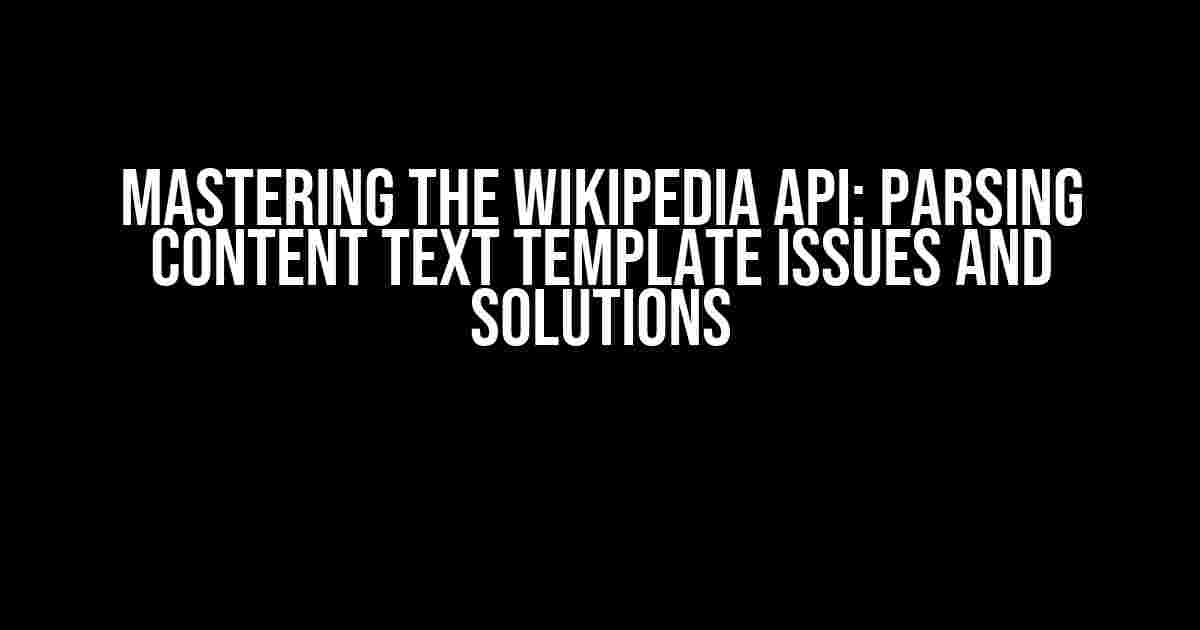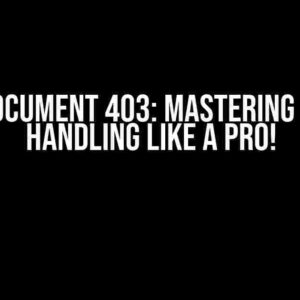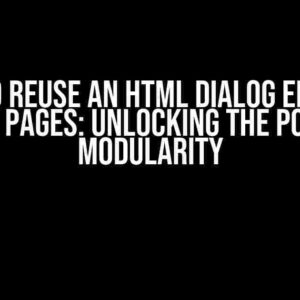As a developer, you’ve likely encountered the Wikipedia API, a powerful tool for tapping into the vast wealth of information on the world’s largest online encyclopedia. However, when working with the API, you may have stumbled upon an error that leaves you scratching your head: “parse content text template does not exist.” Fear not, dear coder, for we’re about to dive into the world of Wikipedia API troubleshooting and explore the ways to overcome this frustrating issue.
Understanding the Wikipedia API
Before we dive into the solution, it’s essential to understand the basics of the Wikipedia API. The API is built around the MediaWiki platform, which powers Wikipedia and its sister projects. The API allows developers to access and manipulate Wikipedia data, including articles, categories, and user information.
The Wikipedia API is divided into several modules, each serving a specific purpose. The most commonly used module is the query module, which allows you to retrieve data from Wikipedia. Within the query module, you can use various parameters to customize your query, such as titles, prop, and format.
What is a Content Text Template?
A content text template is a parameter used in the Wikipedia API to specify the format of the returned data. When you request article content, you can use a content text template to customize the output. For example, you might use a template to remove unnecessary information, such as navigation links or category listings.
In the context of the Wikipedia API, a content text template is a pre-defined format that the API uses to parse the article content. There are several built-in templates available, including wikitext, html, and text. You can also create custom templates to suit your specific needs.
The “Parse Content Text Template Does Not Exist” Error
So, what happens when you encounter the “parse content text template does not exist” error? This error typically occurs when you’ve specified a custom template that doesn’t exist or is not recognized by the API.
Here’s an example of a query that might trigger this error:
https://en.wikipedia.org/w/api.php?
action=query&
titles=Example&
prop=extracts&
format=json&
exintro=1&
explaintext=1&
template=my_custom_templateIn this example, we’re requesting the article content for the page “Example” using a custom template called my_custom_template. If this template doesn’t exist, the API will return an error.
Solution 1: Check Your Template Name
The most common reason for the “parse content text template does not exist” error is a simple typo or incorrect template name. Double-check that your template name is correctly spelled and formatted.
For example, if you’ve created a custom template called my-template, make sure you’re using the correct template name in your API query:
https://en.wikipedia.org/w/api.php?
action=query&
titles=Example&
prop=extracts&
format=json&
exintro=1&
explaintext=1&
template=my-templateSolution 2: Use a Built-in Template
If you’re not using a custom template, try switching to a built-in template to see if the error persists. For example, you can use the wikitext template, which returns the article content in its original format:
https://en.wikipedia.org/w/api.php?
action=query&
titles=Example&
prop=extracts&
format=json&
exintro=1&
explaintext=1&
template=wikitextSolution 3: Create a Custom Template
If you need to create a custom template, you’ll need to define it in your API query. To do this, you’ll need to use the templatedata parameter, which allows you to specify the template format.
Here’s an example of how you can define a custom template:
https://en.wikipedia.org/w/api.php?
action=query&
titles=Example&
prop=extracts&
format=json&
exintro=1&
explaintext=1&
templatedata=|
Template:My Template
{{#ifeq:{{PAGENAME}}|Example|
{{#invoke:String|sub|{{PAGENAME}}|0|5}}
}}
|In this example, we’re defining a custom template called My Template, which extracts the first five characters of the page title.
Best Practices for Working with Content Text Templates
To avoid the “parse content text template does not exist” error and ensure smooth sailing with the Wikipedia API, follow these best practices:
- Double-check your template name for typos and formatting issues.
- Use built-in templates whenever possible to reduce errors.
- Define custom templates using the
templatedataparameter. - Test your API queries in a sandbox environment before deploying them.
- Consult the official Wikipedia API documentation for the most up-to-date information on content text templates.
Conclusion
The “parse content text template does not exist” error can be frustrating, but with these solutions and best practices, you’ll be well-equipped to tackle even the most complex Wikipedia API projects. Remember to double-check your template names, use built-in templates when possible, and define custom templates correctly. Happy coding!
| Error Code | Description | Solution |
|---|---|---|
| parse content text template does not exist | The specified template does not exist or is not recognized by the API. | Check template name, use a built-in template, or define a custom template using the templatedata parameter. |
By following these guidelines and troubleshooting tips, you’ll be able to overcome the “parse content text template does not exist” error and unlock the full potential of the Wikipedia API.
Frequently Asked Question
Having trouble with Wikipedia API parse content text template not existing? Don’t worry, we’ve got you covered! Here are some frequently asked questions to help you out.
What does “Wikipedia API parse content text template does not exist” mean?
This error message typically occurs when the Wikipedia API is unable to find a template specified in the API request. It’s like trying to find a specific book in a library that doesn’t exist! This can happen if the template has been deleted, renamed, or doesn’t exist in the first place.
How can I fix the “Wikipedia API parse content text template does not exist” error?
To fix this error, you’ll need to verify that the template actually exists on Wikipedia. Check the template name for typos, and make sure it’s not a redirect. You can also try searching for the template on Wikipedia to see if it’s been renamed or moved. If you’re still stuck, try reaching out to the Wikipedia API community for help!
What are some common reasons for the “Wikipedia API parse content text template does not exist” error?
Oh, there are a few common culprits! Typos in the template name, deleted or renamed templates, and redirects are often to blame. Additionally, if the template is protected or doesn’t exist in the specific language version of Wikipedia you’re querying, you might encounter this error. Be sure to double-check your API request and template name to avoid these gotchas!
Can I use a different API endpoint to avoid the “Wikipedia API parse content text template does not exist” error?
Yes, you can! If you’re using the `parse` endpoint, try switching to the `query` endpoint instead. The `query` endpoint is more flexible and can help you retrieve the data you need without relying on a specific template. However, keep in mind that you’ll need to adjust your API request accordingly to get the desired results.
What if I’m still stuck with the “Wikipedia API parse content text template does not exist” error?
Don’t worry, friend! If you’ve tried everything and the error persists, reach out to the Wikipedia API community or a developer forum for help. Provide as much detail as possible about your API request, including the template name and endpoint you’re using. With a little patience and persistence, you’ll get the help you need to overcome this obstacle!





![The Mystifying Error: Webhook Sent 400 {“embeds”: [“0”]} The Mystifying Error: Webhook Sent 400 {“embeds”: [“0”]}](https://mamoru.hkhazo.biz.id/wp-content/uploads/sites/381/2024/07/the-mystifying-error-webhook-sent-400-embeds-0-with-text-300x300.jpg)
